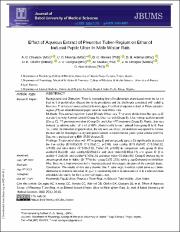| dc.contributor.author | Onuegbu, AC | en_US |
| dc.contributor.author | Nworgu, CC | en_US |
| dc.contributor.author | Ikwuka, DC | en_US |
| dc.contributor.author | Adeniyi, DB | en_US |
| dc.contributor.author | Okafor, OK | en_US |
| dc.contributor.author | Uzoigwe, JU | en_US |
| dc.contributor.author | Nweke, M | en_US |
| dc.contributor.author | Uzoigwe, ZN | en_US |
| dc.contributor.author | Nwachukwu, D | en_US |
| dc.date.accessioned | 1401-12-09T23:13:15Z | fa_IR |
| dc.date.accessioned | 2023-02-28T23:13:16Z | |
| dc.date.available | 1401-12-09T23:13:15Z | fa_IR |
| dc.date.available | 2023-02-28T23:13:16Z | |
| dc.date.issued | 2023-03-01 | en_US |
| dc.date.issued | 1401-12-10 | fa_IR |
| dc.identifier.citation | (1401). مجله علمی دانشگاه علوم پزشکی بابل, 25(1), 36-45. | fa_IR |
| dc.identifier.issn | 1561-4107 | |
| dc.identifier.issn | 2251-7170 | |
| dc.identifier.uri | http://jbums.org/article-1-10837-en.html | |
| dc.identifier.uri | https://iranjournals.nlai.ir/handle/123456789/941214 | |
| dc.description.abstract | Background and Objective: There is increasing desire for pleiotropic plant-based remedies for the treatment of peptic ulcer disease due to its prevalence and the challenges associated with existing therapies. This research was conducted to investigate the effect of aqueous extract of Pleurotus tuber-regium (PT) on ethanol induced peptic ulcer in male Wistar rats.
Methods: This animal experiment used 30 male Wistar rats. They were divided into five groups (6 rats each) namely: Normal control (Group A), Ulcer control (Group B), Ulcer+omeprazole treatment (Group C), PT pre-treatment ulcer (Group D), and Ulcer+PT treatment (Group E). Peptic ulcer was induced by administration of 1 ml of 80% ethanol orally to each animal from group B to E. Four hours after the induction of gastric ulcer, the rats were sacrificed, the abdomen was opened to remove the stomach for histological study and gastric content to determine the gastric juice volume (ml/4 h). Data were analyzed using IBM SPSS Version 25.
Findings: Treatment of ulcer with PT in group E and omeprazole (group C) significantly decreased the free acidity (E=0.83±0.20, C=1.20±0.11, p<0.05), total acidity (E=3.10±0.60, C=9.10±0.32, p<0.05) and ulcer index (E=5.00±2.02, 7.83±4.04, p<0.05) in comparison with group B (free acidity=3.06±1.09, total acidity=22.86±2.51 and ulcer index=32.83±1.74) and group D (free acidity=4.16±0.69, total acidity=17.06±1.91 and ulcer index=35.66±1.96). Group E showed higher percentage of ulcer inhibition (84.77%) than group C (76.15%), while group D showed no inhibition. Also, there were improvements in the macroscopic and microscopic structure of the stomach tissue.
Conclusion: The results of this study showed that P. tuber-regium extract could serve as a better alternative to standard anti-ulcer drugs and considering that it is nutraceutical, it is a safe and more affordable alternative for the treatment of peptic ulcer. | en_US |
| dc.format.extent | 425 | |
| dc.format.mimetype | application/pdf | |
| dc.language | English | |
| dc.language.iso | en_US | |
| dc.publisher | دانشگاه علوم پزشکی بابل | fa_IR |
| dc.relation.ispartof | مجله علمی دانشگاه علوم پزشکی بابل | fa_IR |
| dc.relation.ispartof | Journal of Babol University Of Medical Sciences | en_US |
| dc.subject | Peptic Ulcer | en_US |
| dc.subject | Pleurotus Tuber-Regium | en_US |
| dc.subject | Ethanol | en_US |
| dc.subject | Total Acidity | en_US |
| dc.subject | Ulcer Index. | en_US |
| dc.subject | Pharmacology | en_US |
| dc.title | Effect of Aqueous Extract of Pleurotus Tuber-Regium on Ethanol Induced Peptic Ulcer in Male Wistar Rats | en_US |
| dc.type | Text | en_US |
| dc.type | Experimental | en_US |
| dc.contributor.department | 1.Department of Physiology, College of Medicine, University of Nigeria Enugu Campus, Enugu, Nigeria. | en_US |
| dc.contributor.department | 1.Department of Physiology, College of Medicine, University of Nigeria Enugu Campus, Enugu, Nigeria. | en_US |
| dc.contributor.department | 2.Department of Physiology, School of Medicine & Pharmacy, College of Medicine & Health Sciences, University of Rwanda, Kigali, Rwanda. | en_US |
| dc.contributor.department | 1.Department of Physiology, College of Medicine, University of Nigeria Enugu Campus, Enugu, Nigeria. | en_US |
| dc.contributor.department | 1.Department of Physiology, College of Medicine, University of Nigeria Enugu Campus, Enugu, Nigeria. | en_US |
| dc.contributor.department | 1.Department of Physiology, College of Medicine, University of Nigeria Enugu Campus, Enugu, Nigeria. | en_US |
| dc.contributor.department | 1.Department of Physiology, College of Medicine, University of Nigeria Enugu Campus, Enugu, Nigeria. | en_US |
| dc.contributor.department | 3.Department of Internal Medicine, University of Nigeria Teaching Hospital, Ituku-Ozalla, Enugu, Nigeria. | en_US |
| dc.contributor.department | 1.Department of Physiology, College of Medicine, University of Nigeria Enugu Campus, Enugu, Nigeria. | en_US |
| dc.citation.volume | 25 | |
| dc.citation.issue | 1 | |
| dc.citation.spage | 36 | |
| dc.citation.epage | 45 | |





